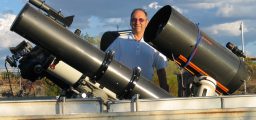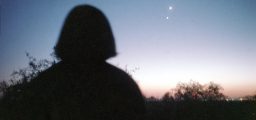June 2022 – Skyward by David Levy

Nothing in the night sky quite beats a total eclipse of the Moon. Other than a shooting star, eclipses prove to all who watch them that the sky is a changing place. During the several hours of a lunar eclipse, we can actually watch as the Moon slowly orbits the Earth, and as it passes through the shadow of the Earth we can enjoy its changing illumination.
Last Sunday evening, May 15, 2022, there was a total eclipse of the Moon. It was perfectly timed for observers throughout most of North America. On the east coast, the eclipse began in mid-evening. For those of us who live in Arizona, in the great American southwest, the eclipse began just as the Moon was rising, and it ended late in the hours of the evening.
As the Moon marched its way eastward, the penumbral shadow manifested itself as a shading, slowly dimming the Moon’s light as it spread across. Gradually the eastward facing limb, or edge, of the Moon grew darker and darker. About 90 minutes into the event, the full and profound darkness of the umbra, the central shadow of the Earth, struck the Moon’s leading edge. Over the next hour or so the Moon lost much of its light.
Seeing an eclipse of the Moon is not the same as experiencing it. To do that, you need also to notice the sky. At Moonrise the sky was very bright, with moonlight swamping everything except the brighter stars. But as the eclipse progressed that night, the sky began to darken gradually, then more obviously as fainter stars appeared, and finally, from a dark site, the Milky Way could be seen. On a personal note, one of the variable stars I observe, TV Corvi (Clyde Tombaugh’s star), cannot be viewed through a telescope when the Moon is near its full phase. But on this night the darkened Moon let the sky get so dark that I easily got a reading of the field of that star. It was yet another aspect of the magic.
The other part of experiencing the eclipse, a completely unexpected part of it, is to learn just how dark the Moon gets during the total phase. There is a scale, the Danjon scale, which ranges from L= 4, where the eclipsed Moon is so bright that you barely notice that there is an eclipse going on at all, all the way down to L=0, during which the Moon is barely visible. If the Earth has suffered a serious volcanic eruption in the months preceding an eclipse, the volcanic dust still remaining high in the Earth’s atmosphere can seriously darken the shadow. I saw one such eclipse on the morning of December 30, 1963. Thanks to the eruption in February 1963 of Indonesia’s Mount Agung volcano, at mid-totality the Moon simply disappeared. Observing from a rural site, my friend Constantine Papacosmas said that the eclipsed Moon was no brighter than a 5th magnitude star.
A few months ago, Mt Hunga Tonga-Hunga Ha’apai, a gigantic undersea volcano about 60 miles north of Tongatapu, Tonga’s main island. and it spewed lots of dust into the upper stratosphere. For this reason, I estimated this eclipsed Moon’s luminosity as L = 1.5. It was the darkest eclipse I have seen since 1963, and Wendee and I thoroughly enjoyed sitting in our observatory watching the wonderful spectacle.
We get to do this all over again in November when a second total eclipse of the Moon will be visible from the Americas. (Because the Moon must pass directly through the Earth’s shadow to be eclipsed, these events can happen only at full Moon. May the sky be clear with the Moon as inviting as it always is. Then you will have another chance to watch the sky in motion, and to watch the world move along not with the trivia and rush of the daily news, but with the slow and solemn, long term march of cosmic time.
——-
Wendee took this picture of the start of the lunar eclipse as the
Moon was rising over a young saguaro cactus plant in our backyard.
Photograph via iPhone by Wendee Wallach-Levy.




Comments are closed.